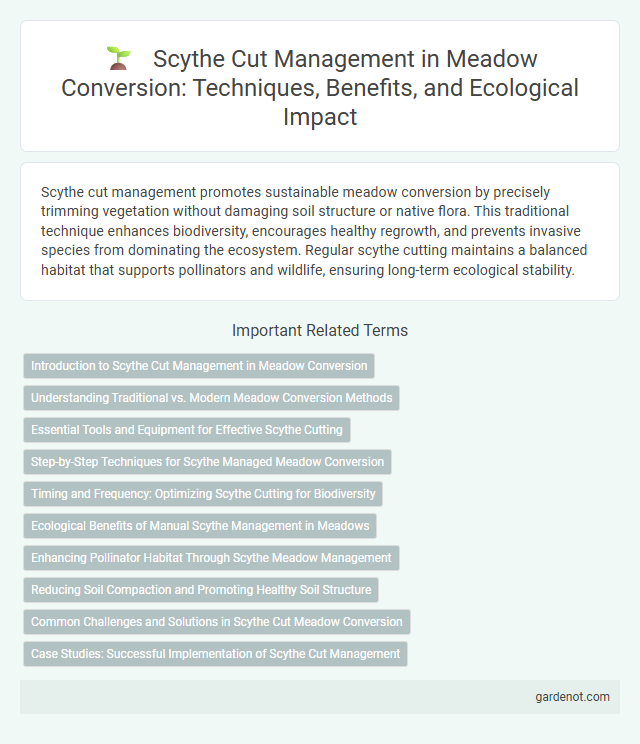Scythe cut management promotes sustainable meadow conversion by precisely trimming vegetation without damaging soil structure or native flora. This traditional technique enhances biodiversity, encourages healthy regrowth, and prevents invasive species from dominating the ecosystem. Regular scythe cutting maintains a balanced habitat that supports pollinators and wildlife, ensuring long-term ecological stability.
Introduction to Scythe Cut Management in Meadow Conversion
Scythe cut management plays a crucial role in meadow conversion by promoting sustainable vegetation control and enhancing biodiversity. This traditional method allows precise cutting of grasses and wildflowers, reducing soil disturbance and supporting native plant regeneration. Effective scythe management improves meadow health, encourages pollinator habitats, and aligns with ecological conservation goals.
Understanding Traditional vs. Modern Meadow Conversion Methods
Scythe cut management in meadow conversion plays a crucial role in maintaining biodiversity and promoting soil health through low-impact, manual mowing techniques. Traditional methods emphasize hand-cutting with a scythe, preserving native flora and minimizing machinery disturbance, while modern approaches often incorporate motorized equipment for efficiency but risk compacting soil and disrupting microhabitats. Comparing these methods highlights the importance of balancing ecological preservation with practical management goals for sustainable meadow restoration.
Essential Tools and Equipment for Effective Scythe Cutting
Effective scythe cut management relies on essential tools such as a sharp, well-balanced scythe with adjustable blades to maximize cutting efficiency and reduce user fatigue. A honing stone and peening jig are critical for maintaining the blade's edge, ensuring clean cuts and prolonging tool lifespan. Complementary equipment like a whetstone, snath handles, and protective gloves enhance precision, safety, and overall productivity in meadow conversion and grassland maintenance.
Step-by-Step Techniques for Scythe Managed Meadow Conversion
Scythe cut management for meadow conversion involves precise step-by-step techniques that promote biodiversity and soil health. Begin by mowing in late summer to allow wildflowers to set seed, followed by raking to remove cuttings and prevent nutrient buildup that favors aggressive grasses. Repeat annual cuts with careful pattern rotation to encourage diverse plant species and maintain an open meadow structure conducive to wildlife.
Timing and Frequency: Optimizing Scythe Cutting for Biodiversity
Optimal timing for scythe cut management in meadow conversion enhances plant diversity by targeting peak growth stages before flowering, preventing dominant species from overshadowing others. Frequent but carefully spaced cuts every 4-6 weeks promote a heterogeneous habitat, supporting a wide range of flora and fauna. This balance maximizes biodiversity while maintaining meadow health and resilience.
Ecological Benefits of Manual Scythe Management in Meadows
Manual scythe cut management in meadows supports biodiversity by promoting a diverse habitat structure, which benefits pollinators and ground-nesting birds. This technique reduces soil compaction and disturbance compared to mechanized mowing, enhancing soil health and microbial activity. Regular scythe cutting allows for selective removal of invasive species, maintaining native flora dominance and ecological balance.
Enhancing Pollinator Habitat Through Scythe Meadow Management
Scythe cut management in meadow restoration promotes a diverse floral structure essential for pollinator habitats by enabling staggered flowering periods and reducing invasive species. Regular, precise cutting supports native wildflowers and grasses, increasing nectar and pollen availability for bees, butterflies, and other pollinators. This method enhances biodiversity, encourages natural pest control, and sustains ecosystem services critical to agricultural and wild landscapes.
Reducing Soil Compaction and Promoting Healthy Soil Structure
Scythe cut management in meadow conversion significantly reduces soil compaction by minimizing heavy machinery use, preserving natural soil porosity and root aeration. This method promotes healthy soil structure by maintaining organic layers and enhancing microbial activity, essential for nutrient cycling and water retention. Implementing scythe cutting supports sustainable meadow ecosystems by fostering resilient soil conditions conducive to plant diversity and growth.
Common Challenges and Solutions in Scythe Cut Meadow Conversion
Common challenges in scythe cut meadow conversion include inconsistent cutting height, regrowth timing, and labor intensity, which can hinder optimal grassland restoration. Solutions involve training operators in precise blade control to maintain uniform cuts, scheduling regular scythe sessions aligned with plant growth cycles, and integrating community labor efforts to distribute workload effectively. Employing sharp blades and ergonomic designs also reduces fatigue and improves cut quality, enhancing meadow biodiversity over time.
Case Studies: Successful Implementation of Scythe Cut Management
Case studies on scythe cut management demonstrate its effectiveness in maintaining meadow biodiversity while promoting sustainable harvesting practices. Research from European grasslands highlights increased plant species richness and improved soil health after implementing regular scythe cutting cycles. These real-world examples confirm scythe cut management as a viable strategy for ecological restoration and cost-efficient meadow maintenance.
Scythe cut management Infographic

 gardenot.com
gardenot.com